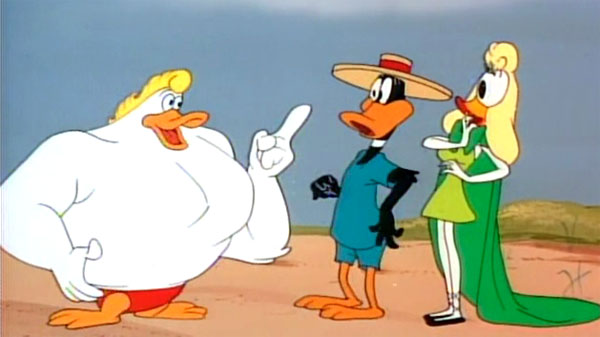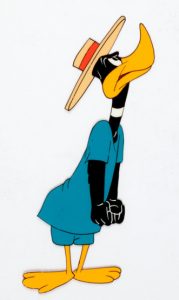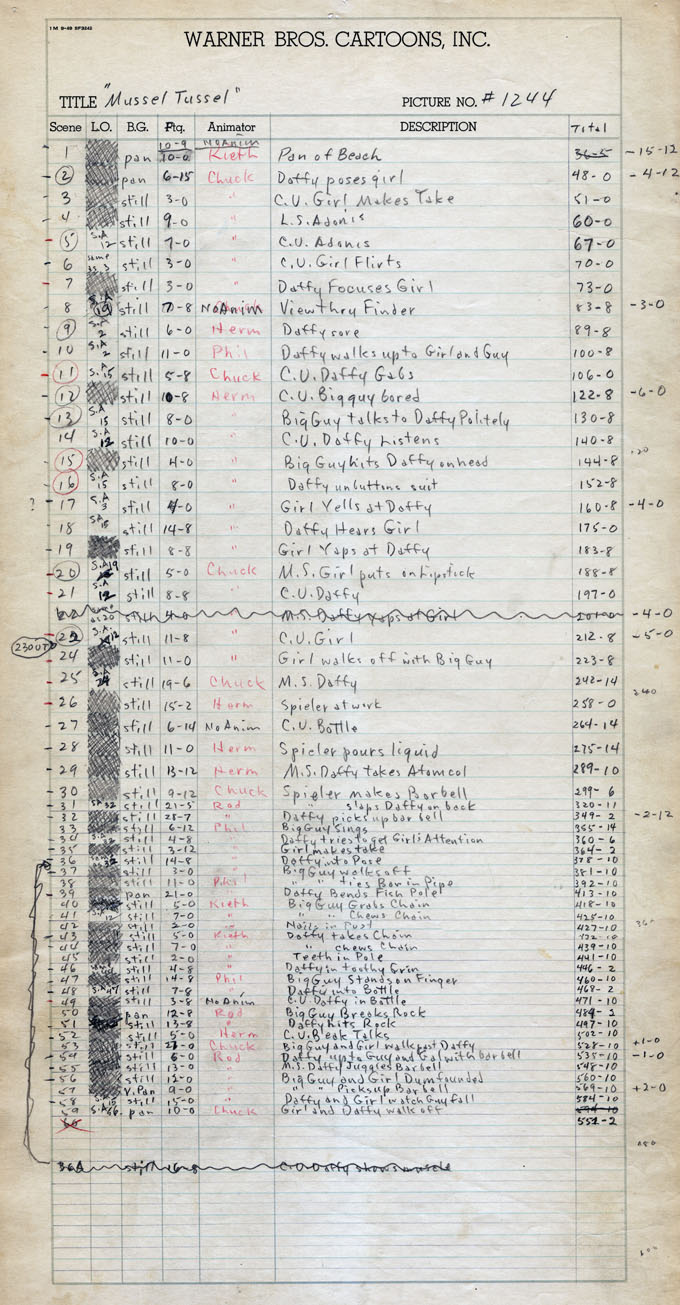
It’s the battle of the brawn in this week’s animator breakdown, with Daffy Duck!
Bob McKimson’s Muscle Tussle is an example of how the Warners cartoons finessed their stories and characterizations, compared to other animation studios. The two-character conflict here—between a muscle-bound duck and the “scrawny, little nine-pound weakling” Daffy Duck on the seaside—would have hewed to a restrained, formulaic pattern had it been made by Famous Studios or Terrytoons. Daffy’s nemesis could have been portrayed as more pugnacious; in McKimson’s film, his few lines of dialogue reveal the manners of a Southern gentleman who only attacks Daffy when provoked.
Based on recent evidence from acquiring the dates for several “jam sessions”—group meetings attended by production manager Johnny Burton, producer Eddie Selzer, the directors and the story men—the story conference for Muscle Tussle may have occurred in late March or early April 1951. The jam session for Chuck Jones’ Forward March Hare—production #1243—occurred on March 23, 1951, and Muscle Tussle was the next cartoon in production, designated as #1244, as indicated on the draft.

Gladys Holland flanked by Leonard Maltin (right) and Jerry Beck (left) in 2011, recording audio commentary for the UPA Jolly Frolics DVD set.
Mel Blanc and Gladys Holland, as Daffy’s high-pitched girlfriend, recorded their dialogue tracks shortly after, on April 14, 1951. Holland was prominent in supporting roles for Lux Radio Theater around the time she provided her voice for this film. Later, Holland recorded her dialogue for Muscle Tussle in a later session on November 6, presumably for pick-up changes. She appeared in other studios’ cartoons, such as the narrator for UPA’s Madeline (1952) and as “Gorgeous Gal” in Walter Lantz’s A Fine Feathered Frenzy (1954). Holland continued to perform in supporting roles on radio and unbilled roles in live-action features, such as Alfred Hitchcock’s To Catch a Thief and The Man Who Knew Too Much.
McKimson’s animators, including an uncredited Keith Darling, are given sustained sequences in the film that play to their strengths. Charles McKimson animates the opening scenes of Daffy’s girlfriend modeling for pictures until the “Adonis” catches her attention. Herman Cohen handles the following scenes, as Daffy admonishes him, only to have his head knocked between his shoulders. His animation continues as Daffy’s girlfriend urges him to fight back, with some great subtle acting as Daffy looks with faux-confidence facing his bully, which disintegrates when he turns back to her.
 Cohen also animates the swindler duck selling Atomcol, a phony elixir guaranteed for “mighty muscles” (and a spoof of Hadacol, the “vitamin supplement” that was 12% alcohol—very popular in dry states—and promoted a traveling medicine show, with the likes of Bob Hope, Hank Williams and Judy Garland, to peddle its wares). Cohen’s sequence ends after the huckster forces a spoonful down Daffy’s throat. Rod Scribner handles Daffy’s violent coughing fit—the contents of the tonic are listed as 90% hot mustard and 10% tap water—and Daffy lifting a mock barbell. In another fine piece of character animation, Daffy approaches the weights slowly and gives a brief worried look to the huckster before lifting it over his head—and off the sand.
Cohen also animates the swindler duck selling Atomcol, a phony elixir guaranteed for “mighty muscles” (and a spoof of Hadacol, the “vitamin supplement” that was 12% alcohol—very popular in dry states—and promoted a traveling medicine show, with the likes of Bob Hope, Hank Williams and Judy Garland, to peddle its wares). Cohen’s sequence ends after the huckster forces a spoonful down Daffy’s throat. Rod Scribner handles Daffy’s violent coughing fit—the contents of the tonic are listed as 90% hot mustard and 10% tap water—and Daffy lifting a mock barbell. In another fine piece of character animation, Daffy approaches the weights slowly and gives a brief worried look to the huckster before lifting it over his head—and off the sand.
The last portion of the cartoon is full of spot gags to prove Daffy is a “virile, red-blooded he-duck,” which are given to Phil De Lara (first challenge: tying a chain around a pole, and third challenge: balancing themselves on a glass soda bottle using only one finger), Keith Darling (second challenge: chewing a chain link and spitting them out as nails), and Rod Scribner (final challenge: smashing a boulder with a sledgehammer).
 Scribner’s timing of Daffy being handed the sledgehammer after mocking his challenger—“Child’s play!”—is a great comic touch. He also animates Daffy showing off his ability with the barbell—twirling it like a bandleader’s baton and balancing it on one foot—up to near the end of the cartoon.
Scribner’s timing of Daffy being handed the sledgehammer after mocking his challenger—“Child’s play!”—is a great comic touch. He also animates Daffy showing off his ability with the barbell—twirling it like a bandleader’s baton and balancing it on one foot—up to near the end of the cartoon.
The music cue sheet for Muscle Tussle is dated July 21, 1952, a year after much of the pre-production began. Carl Stalling incorporates two songs in the film, which were performed in between the production: “Love Ya” (Peter De Rose/Charles Tobias) is played underneath the opening titles, introduced in the Doris Day musical On Moonlight Bay. Another is “Down in Nashville, Tennessee (Chick-A-Ling-Bone),” (Bob Hilliard/David Mann), a 1951 hit tune sung by the muscle-bound duck on his ukulele. In a curious but effective choice, the song that plays underneath the Atomcol sequence is Louis Prima’s 1941 hit “Tica-Ti—Tica-Ta,” used in a few Warners cartoons in the early 1940s.
Stalling also uses certain cues to great effect; in the opening scenes, “You Must Have Been a Beautiful Baby” (Harry Warren/Johnny Mercer), is delicately arranged as Daffy’s girlfriend poses for a picture; a heavy brass section overpowers the scene as the muscle-bound duck enters. The orchestration adds growly trombones to accentuate Daffy’s jealousy when he sees his rival in the camera’s viewfinder.
Later in the cartoon, during the competition between Daffy and his rival, Juventino Rosa’s “Over the Waves (Sobre las Olas)” is heard during these scenes. As with the other music cue, the composition plays gently when the rival performs his tasks correctly, but when Daffy’s ineptitude and difficulty takes over, it shifts to a bouncy, jazz-infused version to comment on his failure.
Muscle Tussle’s general theatrical release occurred on April 18th, 1953, two years after the first dialogue track recording. Enjoy!

NEXT WEEK: A rare treat – a UPA animator breakdown…
(Thanks to Jerry Beck, Keith Scott, Michael Barrier, Frank Young and Yowp for their help.)


 DEVON BAXTER is a film restoration artist, video editor, and animation researcher/writer currently residing in Pennsylvania. He also hosts a
DEVON BAXTER is a film restoration artist, video editor, and animation researcher/writer currently residing in Pennsylvania. He also hosts a 




















































































I never realized that Gladys Holland was the voice of the female duck; oh, if only there were more LOONEY TUNES compilations out there with commentary tracks abounding!! This cartoon does appear, unrestored, on one of the individual laserdisks from Warner Brothers, available years ago. This was an interesting post. There were occasionally some interesting female voices showing up on the cartoons, like the voice of the temptress in “SUPER SNOOPER”.
It was also an extra on the DVD for the John Wayne “comedy” Trouble Along the Way. I really wish Muscle Tussle got a restored release so I could sell that movie.
Wow, I had never seen this one before! It’s pretty darn funny, and has some really good animation in it. Thanks for the breakdown Devon, it adds a lot to the experience.
I know of Miss Holland as the voice from Graham Webb’s “The Encyclopedia of Animated Films” (2000, McFarland Press). And good work, to Bob McKimson for RESISTING Humans, as the UPA influence was taking over… the use of all ducks reminds me of the old 30s-40s cartoons…
Seen it hundreds of times. Never noticed muscle duck had a mullet hairdo.
I’ve seen it many times,too..didn’t notice tyhe mullet till you pointed it out, Dennis.
Saw this on TV way back in the day… They didnt have a name for the he-duck’s hairdo back then!
Yes they did. It was called the “Duck Tail”
In Leave It To Beaver, Wally Cleaver mentioned it in the episode where he goes to the Barber.
This hairstyle was ironically called a “Duck Tail”.